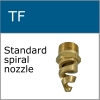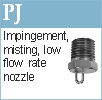Nozzles for the oil, gas and petrochemical industry
Key spray application - Injecting additives into pipes
Injecting additives into gas or oil pipes is a common application for spray nozzles. A lance or quill will be inserted into the pipe to add anti-corrosives or other additives to the fluid/gas flow. When inserting into the pipe the hole size needs to be kept to a minimum so as to preserve the pipe structural integrity. As such the profile of the nozzle being used becomes important. The greater the profile the bigger the hole needs to be.
The spray produced will generally need to be a full cone pattern with relatively small droplet sizes so as to ensure quick and even mixing with the fluid or gas in the pipe. Also in many cases the flow rate of additive needs to remain small so as not to overdose the pipe. One potential issue is that many of the nozzles that produce these spray characteristics (low flow rate, fine sprays with full cone patterns) have a large profile and so necessitate a large insertion hole to be cut into the pipe.
Fast moving flows
Another issue in injection into a very fast moving gas flow is the penetrative power of the spray. If the spray is very fine then this will be optimum for mixing in slower moving flows but in very fast flows the fine mists may get swept along before reaching the edges of the pipe. In this way channels of untreated gas may form.

Suitable nozzles
Suitable nozzles for injection would be the P range of misting nozzles or for smaller applications, the PJ low flow rate variant. For larger applications or for fast moving gas flows a spiral TF or L series nozzle might be appropriate as these nozzles produce some larger droplets which gives the spray more momentum.
The WTZ full cone tangential whirl nozzle has the distinct advantage of spraying perpendicular to the feed pipe. This can greatly reduce the cutting of the pipe.
Full details on each series can be found by clicking on the product boxes below.




